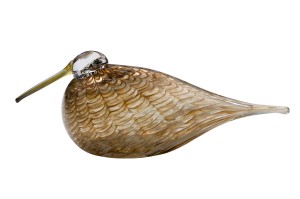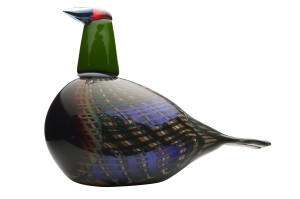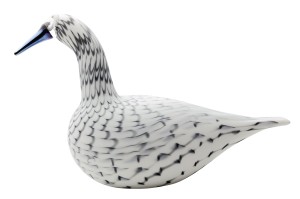The famous Finnish designer and professor has always seen glass as one of his most favourite and most expressive materials to explore and enjoy the opportunities offered, while at the same time making the use of the renowned iittala skilled glass craftsmen and women. With various techniques, colours, the transparency and the opacity of glass. There is great virtuosity in the way that filigree and filigree tape have been used to depict the birds’ plumage. Toikka uses In his birds glass like a painter uses his palette. His ideas spring from nature and of course his abundant imagination. Though it does not necessarily mean that all his birds are all resembles their real life counterparts. The bodies often displays a playful note, characteristic of Oiva Toikka; exquisite, but not too serious.
Annual Flock
This year’s new birds include some graceful individuals, painted with an organic palette, such as the Eurasian Wryneck and the Woodcock. One of the showpieces in the 2007 collection is the magnificent Whooper Swan. For the Annual Bird 2007 the Cloud Tern was chosen. Unlike the tradition of the birds as such, that dates back to 1973, the Annual Bird series started in 1993, when the Nuutajärvi Glass Factory was celebrating its second centenary year. The Eurasian Woodcock has been chosen as this year’s campaign bird. And on top of all these original creatures there is the festive Pheasant, produced in a limited edition of 200, each one individually numbered. It displays the beauty of glass at its most diverse: glowing colours, metallic lustre and multi-hued plumage, skilfully created with heated glass thread.
Whooper Swan
Finally a swan was added to the ever growing collection of glass birds. The long-necked swan, well-loved by Finns. And it is a challenging shape for glassblowers. The swan has been in symbol in Finnish art for centuries. What about ‘The Swan of Tuonela’ by Finland’s leading composer Jean Sibelius or the swans depicted by famous national romantic painters. Toikka’s beautiful swan comes in the pure white of the adult bird or in the light grey plumage of the cygnet. A swan in the form of an artefact is a symbolic gift and always deeply appreciated by the recipient.
Origins
The first birds created by Oiva Toikka together with the famous glassblowers of the Nuutajärvi Glass Factory, the oldest in Finland, saw the light of day in 1973. It was a Flycatcher, appearing in different colour variations. Over 300 species have now been created, some of them more enduring in production than others. This year, Birds by Toikka, contains 43 different species. Within the iittala range, the birds stands out as a collection of individualistic interior decoration elements, to be used to add distinctive detail to your home interior. The series is an internationally renowned concept that belongs in the highest echelons of glass production.
Nuutajärvi
Birds by Toikka is a collection with a simple, natural theme, taking the beholder forward along an age-old path of tradition. Each bird is a unique and signed with the artist’s name as well as the name of Nuutajärvi – it is the tangible product of skilled artisanship. The passing of time enhances the value of these objets d’art. That is why the birds of this accomplished master are cherished and valued gifts and irresistible to collectors around the world, from Finland to the United States and from Hungary all the way to Japan.
(May 22, 2007, by Leslie Leijenhorst)




